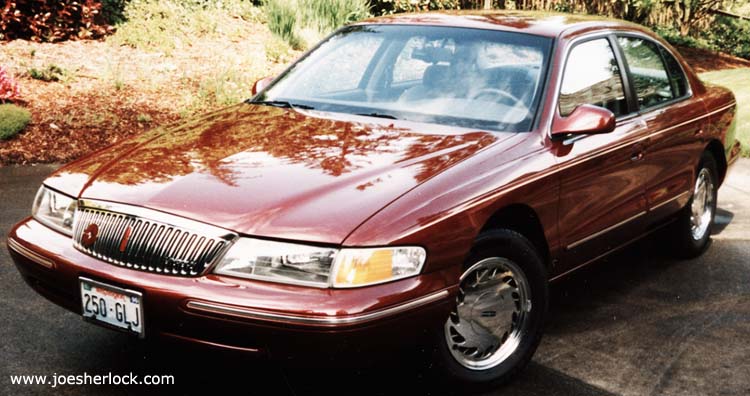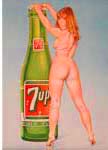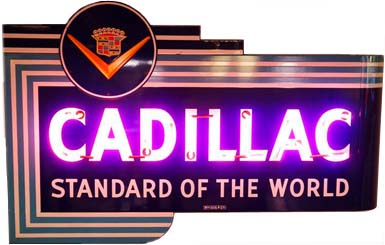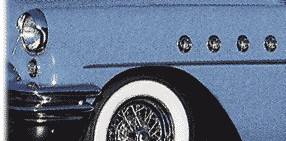|
Branding: The Battle For The Car Buyer's Mind
In 1980, marketing gurus Al Ries and Jack Trout wrote 'Positioning: The Battle for Your Mind'.
Positioning is also defined as the way by which the marketers attempt to create a distinct impression or perception in the customer's mind; specifically, "the place a product, brand, or group of products occupies in consumers' minds relative to competing offerings."
Perception is reality - you are whatever other people think you are. Branding is part of the positioning/perception process. The principles outlined in Ries & Trout's various books are applicable to all types of products and companies in all industries.
As an aside, I would note that, in late 1986, I read 'Marketing Warfare' by Ries & Trout - another wonderful business book by the duo. I read it three times and then declared war on my biggest competitor in the plastic display business. In 12 months, I obtained over $1 million in increased business as a result of my 'warfare' strategy. Our firm's market share jumped by double-digits.

Because our customers were now buying on factors other than price, we were able to raise prices and improve profitability by an average of 11.7%. Interestingly, good marketing warfare contains elements of perception and positioning. And proper branding.
Back to the auto industry: Autoextremist Peter De Lorenzo called 'branding' "image wrangling" and noted that it is now the Number One priority in the auto business. Peter explained: "Why? The democratization of technology and luxury has allowed auto manufacturers the world over to have access to the crucial ingredients that make automobiles desirable. And with supplier expertise greater than ever, any car company can dial up a witch's brew of ingredients to compete in almost any given segment they set their sights on."
Things such as power windows, automatic door locks, rear window defrosters and premium sound systems were once the provenance of luxury brands. Now, even the cheapest cars offer such amenities - sometimes as standard equipment. High volumes and the reduced cost of technology made such democratization possible.
Sports cars once held the lead on handling and performance. That began to change when sports sedans, such as BMW 2000 ti came along in the late 1960s. Thanks to engineered suspensions, disc brakes, ABS, traction and stability controls and engines which routinely surpass the old one horsepower per cubic inch benchmark, every ordinary sedan can now be driven like a sports car. Jack Baruth track-tested a base, four-cylinder Toyota Camry SE with street tires at Summit Point Raceway and produced very respectable lap times from this lowly rental car.
BMW touted itself as The Ultimate Driving Machine for many years, implying that it could run circles around other brands in performance. Matching up a top-level 1998 BMW 740iL against the much-maligned, front-wheel drive Lincoln Continental sedan of the same era, using data from Motor Trend, I came up with the following chart:
|
Model
Tested
|
Acceleration
(0-60 mph)
|
Quarter-Mile
Performance
|
Lateral
Acceleration
|
Salom
Speed
|
Braking
(60 mph-0)
|
EPA Fuel
Economy
|
| BMW 740iL |
7.9 seconds
|
16.0 sec. @ 92.8 mph
|
0.82 g
|
62.1 mph
|
122 ft.
|
17/24 mpg
|
| Lincoln Continental |
7.7 seconds
|
15.9 sec. @ 89.1 mph
|
0.82 g
|
62.3 mph
|
128 ft.
|
17/25 mpg
|
Not much difference, is there? And yet, who would ever perceive a Lincoln as The Ultimate Driving Machine?

 Differences between brands now come down to perception, regardless of the objective truth. Al Ries and Jack Trout related the story of 7-Up, an undistinguished lemon/lime flavored carbonated soft drink, which was lost in a sea of other non-cola sodas. Differences between brands now come down to perception, regardless of the objective truth. Al Ries and Jack Trout related the story of 7-Up, an undistinguished lemon/lime flavored carbonated soft drink, which was lost in a sea of other non-cola sodas.
In the early 1970s, a brilliant J. W. Thompson ad campaign gave it the slogan 'The Uncola'. You can be sure that other manufacturers who made cola-free products - Hires Root Beer, Canada Dry Ginger Ale, Bubble-Up, Mountain Dew, et al - were quite miffed. But they couldn't proclaim, "Hey, we're an uncola, too!" because it made them look like Johnny-come-lately losers. Only one brand could 'own' a position. In this case it was 7-Up, which soon became the third-best selling soft drink in America.
Here's another example of perception and branding used in the restaurant business: Charles G. Hill has pointed out that the "highly-prized Chilean sea bass used to be known as the Patagonian toothfish."
"To make it more appealing to Americans, fish wholesaler Lee Lantz coined the name "Chilean Sea Bass." The resulting surge in the fish's popularity made it a staple at chic restaurants, but it also devastated the Antarctic’s wild toothfish stock." In Chile; there, it's referred to as "Bacalao de profundidad" — "cod of the depths."
'Standard of the World' became a Cadillac slogan early in the 20th Century. At first, the phrase referred to Cadillac's standardization of mechanical components due to precision manufacturing.
 Later, the slogan was used to indicate Cadillac's standing in the world of the wealthy and powerful. If you look at period newsreel footage, you'll see potentates, dictators, popes, celebrities and gangsters being ferried about in shiny black Caddys. Later, the slogan was used to indicate Cadillac's standing in the world of the wealthy and powerful. If you look at period newsreel footage, you'll see potentates, dictators, popes, celebrities and gangsters being ferried about in shiny black Caddys.
Pope Pius XII had several Cadillacs (prewar and postwar), including a Derham-bodied model with a throne in the back seat that could be elevated. Al Capone owned an armored Caddy. In those days, Cadillac was indeed the Standard of the World.
On that basis, Packard and Mercedes could have claimed that they were Standards of the World, too, having also been used by royalty and major-movers and shakers throughout the world. But Caddy beat them to it and, therefore, owned that position.
Then there's the Lexus story. Introduced in 1989 at a price 40% less than Mercedes and only 10 to 20% above Lincoln and Cadillac, this car (with no history and no heritage) rocketed past its pedigreed competitors to become a top-selling luxury brand in the U.S. It's slogan was 'The Relentless Pursuit of Perfection'. The brand attracted dissatisfied owners of other luxury marques - those, for example, who were fed up with Cadillac's quality or Mercedes' high maintenance costs.
Amazingly, Lexus' sales success was done without rebates or rental car sales. Lexus has forced its competition to make better cars. By 1999, Lexus was outselling every luxury car brand in the U.S., except Mercedes. Today, sales of Lexus, Mercedes-Benz and BMW are very close.
Fifty years from now, they'll still be using the Lexus Marketing Jihad as a business case study at the Wharton School and at Harvard.
Today, wanna-be luxury cars, such as Acura, Infiniti and Lincoln, lack a coherent, cohesive position and their sales suffer because of it. Discussing the Infiniti brand, Peter De Lorenzo noted that "this car company is so hungry to be considered on par with Audi, BMW and Mercedes-Benz that it's starting to wear the ghostly pallor of desperation."
Infiniti made its U.S. debut around the same time as Lexus. But it stumbled out of the gate and never recovered. The initial advertising campaign had Zen-influenced spots that focused on nature and tranquility, without showing actual cars. Industry pundits derided these 'rocks and twigs' ads, which confused prospective buyers.
Furthermore, designers failed to adorn the interiors with the typical wood accents and chrome brightwork, opting instead for a monochrome appearance focusing on padded leather and vinyl throughout. This made the car look 'cheap' to American luxury buyers and they went elsewhere to purchase vehicles with the requisite luxury touches to which they were accustomed. Infiniti remains a confused brand and has never been accorded full luxury status by buyers. Today, Lexus outsells Infiniti by about 2.5 to 1.
On the other hand, Audi has moved up as a luxury brand over the last couple of decades. When Audi was introduced to the U.S. in the 1970s, its offerings were mostly glorified Volkswagen. Over a three-decade period, Audi has gradually gained prestige status in America, even though its entry-level models are still VW-based. De Lorenzo wrote that "Audi's impeccable image has gone from being very warm to the touch on the AE Brand Image Meter last year to again being the quintessential definition of brand hotness this year." These days, Audi is the fourth best-selling luxury auto brand in the U.S., behind Mercedes-Benz, BMW and Lexus.
 Buick once was a dignified, slightly lower-priced alternative to a flashy Cadillac. It was a car owned by doctors and bankers. Over the past 40 years, Buick has devolved into a geezermobile; the average age of a Buick owner is slightly more than 60 years old. Buick once was a dignified, slightly lower-priced alternative to a flashy Cadillac. It was a car owned by doctors and bankers. Over the past 40 years, Buick has devolved into a geezermobile; the average age of a Buick owner is slightly more than 60 years old.
In 1985, Buick sold over one million automobiles in the U.S. Today, it struggles to find buyers for the 218,000 vehicles it produces annually.
AutoExtremist decreed, "Buick remains in automotive limbo for now, which, according to the AE Brand Image Meter, can be a cold, disheartening place. ... A new Riviera would do wonders, but don't hold your breath that will happen anytime soon."
Positioning/Branding is difficult work, especially in the automobile business where too many models are chasing the same aspiration. Changing public perception for an established brand is as difficult as pushing a Dumpster through a magnet factory. But it can be done.
In each market segment, there can only be one winner, position-wise. Usually, that winner becomes sales king in the segment. (posted 7/7/15)
But Wait - There's More: Earlier, I wrote an article (above) about the importance of product branding and the role perception plays in market success. I provided numerous automotive and non-automotive examples of how branding works. When possible, I provided data to show what a difference good/bad perception can make including sales data.
 Positioning is defined as the way by which the marketers attempt to create a distinct impression or perception in the customer's mind; specifically, "the place a product, brand, or group of products occupies in consumers' minds relative to competing offerings." Positioning is defined as the way by which the marketers attempt to create a distinct impression or perception in the customer's mind; specifically, "the place a product, brand, or group of products occupies in consumers' minds relative to competing offerings."
Perception is reality - you are whatever other people think you are. Branding is part of the positioning/perception process. The principles outlined in Ries & Trout's various business books are applicable to all types of products and companies in all industries.
Here's another food example from Charles G. Hill: "The highly-prized Chilean sea bass used to be known as the Patagonian toothfish."
"To make it more appealing to Americans, fish wholesaler Lee Lantz coined the name “Chilean Sea Bass." The resulting surge in the fish's popularity made it a staple at chic restaurants, but it also devastated the Antarctic’s wild toothfish stock."
In Chile, it's now referred to as "Bacalao de profundidad" - "cod of the depths." So there. (posted 9/16/15, permalink)
Other Pages Of Interest
| blog: 'The View Through The Windshield' |
| greatest hits: index of essays & articles | blog archives | '39 Plymouth |
| model train layout | about me | about the blog | e-mail |
copyright 2015-21 - Joseph M. Sherlock - All applicable rights reserved
Disclaimer
The facts presented on this website are based on my best guesses and my substantially faulty geezer memory. The opinions expressed herein are strictly those of the author and are protected by the U.S. Constitution. Probably.
Spelling, punctuation and syntax errors are cheerfully repaired when I find them; grudgingly fixed when you do.
If I have slandered any brands of automobiles, either expressly or inadvertently, they're most likely crap cars and deserve it. Automobile manufacturers should be aware that they always have the option of trying to change my mind by providing me with vehicles to test drive.
If I have slandered any people or corporations, either expressly or inadvertently, they should buy me strong drinks (and an expensive meal) and try to prove to me that they're not the jerks I've portrayed them to be. If you're buying, I'm willing to listen.
Don't be shy - try a bribe. It might help.
|